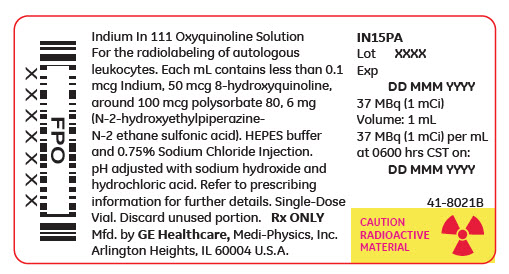FDA records indicate that there are no current recalls for this drug.
Are you a medical professional?
Trending Topics
Indium In 111 Oxyquinoline Recall
Get an alert when a recall is issued.
Questions & Answers
Side Effects & Adverse Reactions
The content of the vial of indium In 111 oxyquinoline solution is intended only for use in the preparation of indium In 111 oxyquinoline labeled autologous leukocytes, and is not to be administered directly. Autologous leukocyte labeling is not recommended in leukopenic patients because of the small number of available leukocytes.
Due to radiation exposure, indium In 111 oxyquinoline labeled leukocytes could cause fetal harm when administered to pregnant women. If this radiopharmaceutical is used during pregnancy, the patient should be informed of the potential hazard to the fetus.
Indium In 111 oxyquinoline labeled autologous leukocytes should be used only when the benefit to be obtained exceeds the risks involved in children under eighteen years of age owing to the high radiation burden and the potential for delayed manifestation of long-term adverse effects.
Legal Issues
There is currently no legal information available for this drug.
FDA Safety Alerts
There are currently no FDA safety alerts available for this drug.
Manufacturer Warnings
There is currently no manufacturer warning information available for this drug.
FDA Labeling Changes
There are currently no FDA labeling changes available for this drug.
Uses
Indium In 111 oxyquinoline is indicated for radiolabeling autologous leukocytes.
Indium In 111 oxyquinoline labeled leukocytes may be used as an adjunct in the detection of inflammatory processes to which leukocytes migrate, such as those associated with abscesses or other infection, following reinjection and detection by appropriate imaging procedures. The degree of accuracy may vary with labeling techniques and with the size, location and nature of the inflammatory process.
Indium In 111 oxyquinoline labeled leukocyte imaging is not the preferred technique for the initial evaluation of patients with a high clinical probability of an abscess in a known location. Ultrasound or computed tomography may provide a better anatomical delineation of the infectious process and information may be obtained more quickly than with labeled leukocytes. If localization by these techniques is successful, labeled leukocytes should not be used as a confirmatory procedure. If localization or diagnosis by these methods fails or is ambiguous, indium In 111 oxyquinoline labeled leukocyte imaging may be appropriate.
History
There is currently no drug history available for this drug.
Other Information
Indium In 111 oxyquinoline (oxine) is a diagnostic radiopharmaceutical intended for radiolabeling autologous leukocytes. It is supplied as a sterile, non-pyrogenic, isotonic aqueous solution with a pH range of 6.5 to 7.5. Each mL of the solution contains 37 MBq, 1 mCi of indium In 111 [no carrier added, >1.85 GBq/µg indium (>50 mCi/µg indium)] at calibration time, 50 µg oxyquinoline, 100 µg polysorbate 80, and 6 mg of HEPES (N-2-hydroxyethyl-piperazine-N'-2-ethane sulfonic acid) buffer in 0.75% sodium chloride solution. The drug is intended for single use only and contains no bacteriostatic agent. The radionuclidic impurity limit for indium 114m is not greater than 37 kBq, 1 µCi of indium 114m per 37 MBq, 1 mCi of indium In 111 at the time of calibration. The radionuclidic composition at expiration time is not less than 99.75% of indium In 111 and not more than 0.25% of indium In 114m/114.
Chemical name: Indium In 111 Oxyquinoline.
The precise structure of the indium In 111 oxyquinoline complex is unknown at this time. The empirical formula is (C9H6NO)3 In 111.
Sources
Indium In 111 Oxyquinoline Manufacturers
-
Medi-physics Inc. Dba Ge Healthcare.
![Indium In 111 Oxyquinoline (Indium In-111 Oxyquinoline) Solution [Medi-physics Inc. Dba Ge Healthcare.]](/wp-content/themes/bootstrap/assets/img/loading2.gif)
Indium In 111 Oxyquinoline | Medi-physics Inc. Dba Ge Healthcare.
![Indium In 111 Oxyquinoline (Indium In-111 Oxyquinoline) Solution [Medi-physics Inc. Dba Ge Healthcare.] Indium In 111 Oxyquinoline (Indium In-111 Oxyquinoline) Solution [Medi-physics Inc. Dba Ge Healthcare.]](/wp-content/themes/bootstrap/assets/img/loading2.gif)
The recommended adult (70 kg) dose of indium In 111 oxyquinoline labeled autologous leukocytes is 7.4 to 18.5 MBq, 200-500 µCi. Indium In 111 oxyquinoline solution is intended for the radiolabeling of autologous leukocytes. The indium In 111 oxyquinoline labeled autologous leukocytes are administered intravenously.
Imaging is recommended at approximately 24 hours post injection. Typically, anterior and posterior views of the chest, abdomen and pelvis should be obtained with other views as required.
Aseptic procedures and a shielded syringe should be employed in the withdrawal of indium In 111 oxyquinoline from the vial. Similar procedures should be employed during the labeling procedure and the administration of the labeled leukocytes to the patient. The user should wear waterproof gloves during the entire procedure. The patient's dose should be measured by a suitable radioactivity calibration system immediately before administration. At this time, the leukocyte preparation should be checked for gross clumping and red blood cell contamination.
Login To Your Free Account


